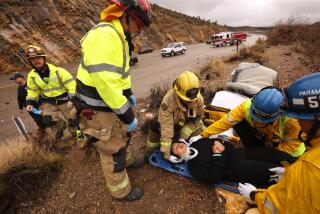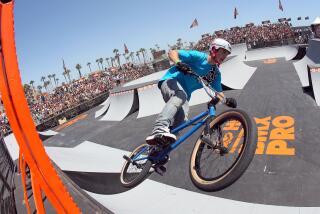Boy Dies When ATC Goes Out of Control
An 11-year-old East County boy was thrown to the ground and fatally injured during his first ride on a three-wheel, all-terrain cycle, authorities said Thursday. Because of safety concerns, such vehicles are no longer manufactured.
Casey James Coker, who lived on the 200 block of Park Boulevard in Crest, died at Sharp Memorial Hospital at 8:40 p.m. Wednesday, about two hours after he was thrown from an ATC that he was learning to ride, said Officer Terry Brollini of the California Highway Patrol.
The accident occurred at Crest Elementary School on the Suncrest Boulevard, where Casey was scheduled to begin the fifth grade in two weeks.
The boy, some friends and his older brother, Tony, were at the school playground with a 1983 three-wheel Honda ATC belonging to William Shimp, Brollini said. Shimp’s son, Shannon, had taken it out to ride, he said.
According to children who were at the scene of the accident, Casey had been “begging to ride it,” Brollini said.
The boy had just started riding the ATC and was going in circles on the basketball court when the vehicle accelerated and went out of control, Brollini said.
The ATC then went off the pavement, onto a dirt field and headed toward a grove of eucalyptus trees, Brollini said. When the Honda hit a 6-inch-high dirt embankment, it went slightly airborne. Casey, who was not wearing a helmet, was thrown from the ATC when it landed. As he flew off it, the boy struck his head on the back of the cycle.
It is unknown why the boy accelerated, but Brollini speculated that he accidentally gave the Honda full throttle. The throttle is situated on the handlebars. “He may have been hanging on too tight and hit it,” Brollini said.
At first, Brollini said, witnesses did not think it was a serious accident. “It was a surprise to all that it ended up as a fatal,” he added.
In 1986 and 1987, ATCs caused about 20 deaths and 7,000 injuries a month. Honda Motor Co. and three other manufacturers of ATCs agreed to stop selling the three-wheel cycles, buy back those in dealer inventories, place warning labels on vehicles and launch a nationwide safety-training campaign.
The companies also agreed to raise the minimum operating age for most vehicles to 16 and mail letters to ATC owners alerting them of safety risks. About half of the victims of the estimated 880 deaths and 300,000 injuries from 1982 to 1988 were under 16.
More to Read
Sign up for Essential California
The most important California stories and recommendations in your inbox every morning.
You may occasionally receive promotional content from the Los Angeles Times.










